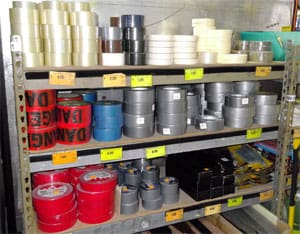Boats, whether power or sail, are constructed using fiberglass, metals, woods, composites, wire, hoses, fabrics and many more materials. And, because they are boats, there is one steadfast rule: things break. Of course, things never break in convenient locations or at optimal times. Having supplies on board your yacht is critical to make repairs — either temporary or permanent. There are all types of things you need to “hold it together” — including bolts, screws, glues, epoxies and line. Besides emergency repairs, there is always the need to do regular maintenance, repairs and upgrades on your boat — sometimes in exotic locations. So whether a worldwide cruiser or a weekend boater, here’s a list of various tapes (in no order of importance) that are handy to have for quick repairs or long-term cruising maintenance and projects. They serve various purposes and are usually easy to find and store on board.
Duct tape: Also called gaffer’s tape or utility tape, this is that gray ultra-sticky stuff that has held many a boat together for years. It comes in several widths and varieties, some stickier than others. Gaffer’s tape tends to leave less sticky residue than Duct tape. Whole TV shows have been done on the many uses of this tape and it is a “must-have” on board. It is flexible and seems to hold up when wet, as long as it’s put on when the surface is dry. Some of it does leave a residue when you try to remove it, so it’s best used on stuff where it will stay.
Electrical tape: The black electricians’ tape is a must-have for any electrical work, especially on a boat when you want to keep moisture away from your wiring. In fact, you may want this tape in a few colors to also help label the wires (positive, negative, ground) by using a specific colored tape for each.
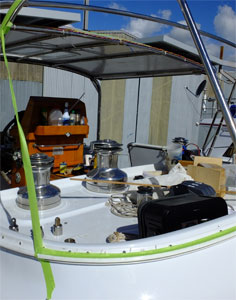 |
|
Tape at work holding a new dodger during installation. |
|
Michael Hawkins |
Painters’ tape: This blue or green tape is handy when doing any painting, varnishing or coating on board. It comes off cleanly without leaving residue and keeps your work tidy. None of us can paint a straight line, so it is really handy for painting the ever-changing waterline. It also comes in green, which seems to work better around corners. When caulking, it is also handy to keep the mess off any area where you don’t want it — making clean up easier.
Reflective tape: Put it on your rain gear, your boat or on your outboard, and in the dark it’s amazing how easy it is to see when a light is flashed against it. Great for coming back after dark in a crowded anchorage and making sure you head to the right boat. And when your dinghy goes for a “walkabout” you can spot it better at night.
Double-sided tape: Want to hang something on a wall and not ruin your beautiful woodwork? Double sided tape, cellophane or foam could be your answer. This tape is also handy for minor repairs like wood or Formica separating. A small piece can also get rid of a creaky area by providing enough padding, and it will stay in place. Put it on the end of a stick and you can pick up that nut or bolt that dropped in your bilge out of reach.
Transparent tape: Things like envelopes that have adhesive on them never seem to work after a few months in humid onboard conditions. A little transparent tape can reseal that envelope. Plus, who knows when you need to wrap a present to celebrate a birthday or just keep your “crew” happy. Also handy to fix that torn paper chart (you remember those, right?)
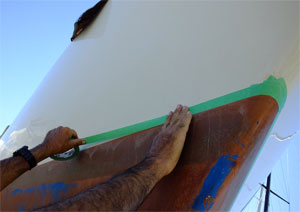 |
|
Painters’ tape in action, masking a waterline. |
|
Michael Hawkins |
Thread seal tape: Before you put that once leaky fixture back together, wrap this thin white tape around the pipe fitting for a better seal. Sometimes called “plumbers’ tape” or “pipe tape,” this stuff can also help make the parts easier to take apart again. You have plenty of water to worry about — a leaky pipe shouldn’t be one of them!
Packing tape: Back to the steadfast boat rule: Things break. You will need to send some piece of equipment back to the manufacturer or to a repair shop at some point. It also works to help store those seldom-used goods in plastic boxes, keeping the lid in place in rolling conditions.
White paper tape: This is great for marking things aboard — especially if you often have guests. If you don’t have fancy labels for everything, a small patch of white tape and a sharpie marker can do the trick to label your halyards, thru-hulls, wiring or sheets. So when you yell, “pull up the main halyard,” your guest can find which line to haul.
Sail repair tape: A bit of this tape can keep a small sail tear from getting bigger before you can get it to the loft. A smaller repair means a less expensive and easier fix! When cruising, sail repair shops are few and far between so this can keep you on the move.
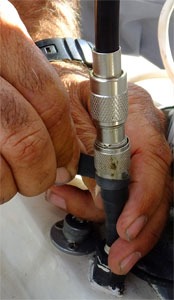 |
|
Self-amalgamating tape applied to a coaxial cable connector. |
|
Michael Hawkins |
Chafing tape: White tape, electricians’ tape or almost any type of tape can work to keep the chafe down on board. Put it around areas where your sheets or lines or sails seem to rub constantly. But be careful to check under that tape occasionally for corrosion.
Bandages: You’re on a boat and things break, and sometimes it may be you or your crew. You’ll get some nicks and cuts. Have a good supply and variety of bandages in your first aid kit for fingers and toes and cuts and scrapes. There are all types of waterproof and “active” bandages today that help keep the cuts covered and dry. For the big bleeders, a good set of butterfly closures is also handy — though hopefully you’ll never need them.
Self-amalgamating tape: If you need tape to stick to tape for a waterproof seal, you’ll want some of this stuff aboard. Great for wrapping electrical connections and sealing out the elements.
Denso tape: This is the petrolatum-soaked version of the self-amalgamating tape above. Once you put it over a connection or part (making sure it is ultra clean), you squeeze it so no water or air can get in while keeping your connection lubricated like new! We learned about this tape from a New Zealand Meteorological Service agent who has to repair equipment in remote locations like the island of Tuvalu. It comes in different sizes and levels of stickiness. We now have it on our antennae wire and windlass motor.
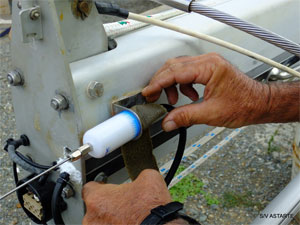 |
|
Denso tape applied to a masthead VHF antenna. This is a good solution for equipment exposed to weather. |
|
Michael Hawkins |
Sewing tape: This double-sided tape is great for any canvas sewing or repair. Sunbrella fabric is hard to pin, but this tape will hold a seam together and you can stitch right over it for an easier sewing project or repair. It takes the swearing out of sewing.
Unlike the huge variety of head types, lengths, widths, thread-size, and wood or metal screws, tapes are a handy solution to many quick and temporary fixes or when doing major projects on board. They don’t weigh much and it’s amazing how often you’ll use them.
Now if they would only invent the tape to keep your marriage together! Wait, perhaps a little gaffer’s tape over the captain’s mouth would work … just kidding!
Barbara Sobocinski and Michael C. Hawkins have been voyaging for five years aboard their 1987 Moody 422 Astarte. Prior to becoming full-time cruisers they both worked in the television industry.

